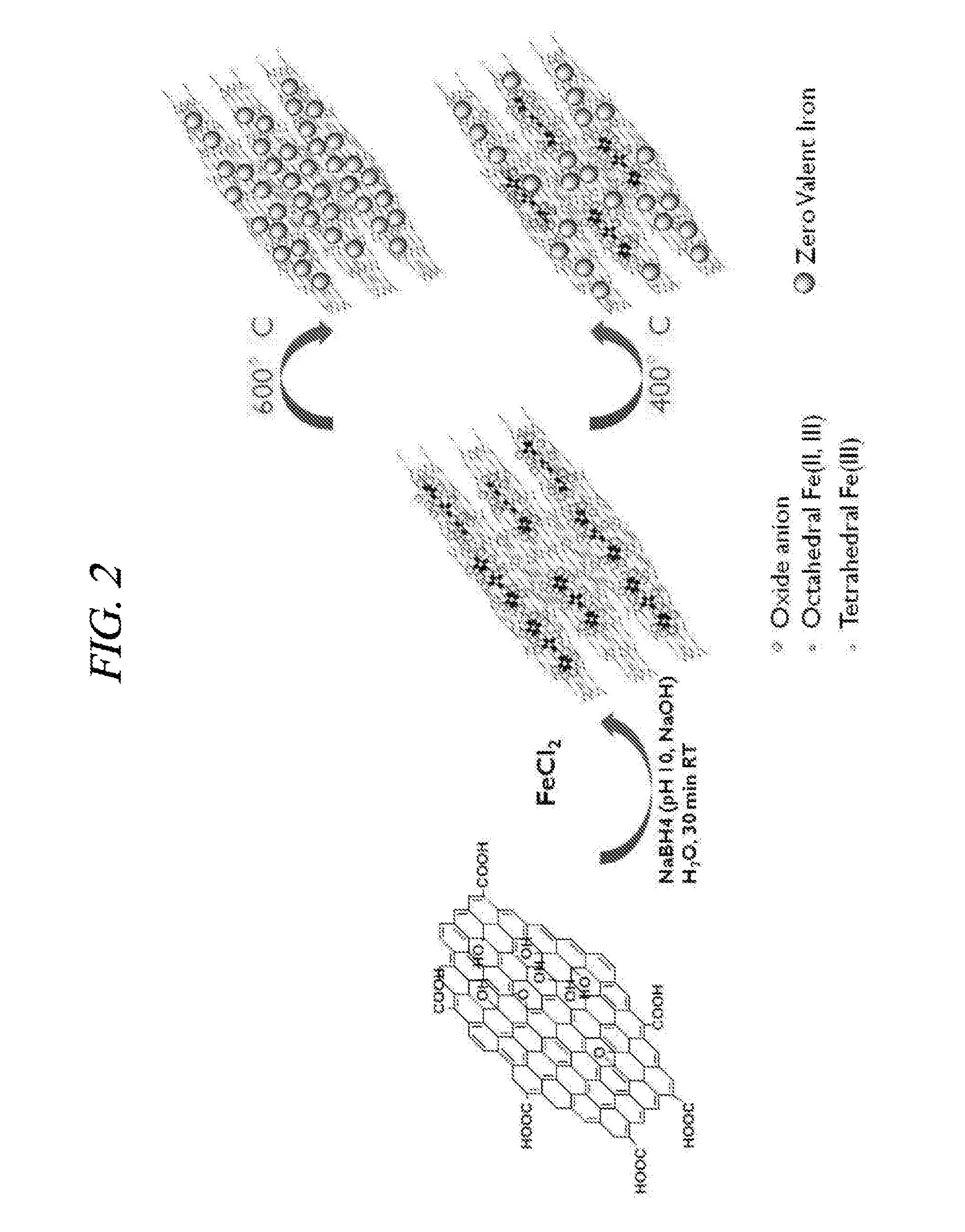Composite containing metal component supported on graphene, preparing method of the same, and uses of the same
a metal component and graphene technology, applied in the field of composite including a metal component supported on graphene, can solve the problems of rapid oxidation, rapid washed away, and inability to use, and achieve the effects of easy adsorption of contaminants, good dispersion, and high quality
- Summary
- Abstract
- Description
- Claims
- Application Information
AI Technical Summary
Benefits of technology
Problems solved by technology
Method used
Image
Examples
example
Example 1
Preparation of Composite
[0077]1. Preparation of Reduced Graphene Oxide-Supported Zero-Valent Iron (RGO-ZVI)
[0078]Above all, there was a process in which triiron tetraoxide (Fe3O4) was supported on a reduced graphene oxide. About 1 ml of 1 M FeCl2 was put into a round flask filled with a nitrogen gas with stirring and a reduced graphene oxide aqueous solution having a concentration of 20 mg / 5 ml was added thereto. Then, about 3 ml of a solution in which 1.6 M sodium borohydride (NaBH4) dissolved in an alkaline solution set to about pH 10 by using NaOH was dropwisely added to slurry at a rate of 1 ml per minute at about 25° C. Thereafter, a resultant mixture was maintained at the same temperature in a nitrogen atmosphere for about 30 minutes. After a reaction was completed, it was centrifuged at about 5000 rpm for about 20 minutes in order to remove non-reacted FeCl2 and NaBH4 from the aqueous solution. The solvent was changed into acetone immediately and the centrifugation w...
example 2
Removal of Heavy Metal with Composite
[0084]An experiment for removing heavy metals such as arsenic (As), chromium (Cr), lead (Pb), cadmium (Cd), and mercury (Hg) was carried out by using the composite including the iron component supported on graphene prepared in Example 1.
[0085]To be specific, each of arsenic oxide (As2O3), chromium oxide (CrO3), lead nitrate (PbNO3), cadmium chloride (CdCl2), and mercury chloride (HgCl2) was used as a reactant.
[0086]Above all, an aqueous solution in which an arsenic oxide (As2O3) dissolved at a concentration of about 10 ppm was put into a glass beaker. Samples of the composite including the iron component supported on graphene heat-processed at about 400° C. and 600° C. were dispersed in water at a concentration of about 0.7 mg / ml and could be separated from the water by using a magnet (FIG. 9). The separation of the composite including the iron component supported on graphene prepared in Example 1 was nearly completed with a magnetic field of abo...
example 3
Adsorption and Removal of Methylene Blue or Methyl Orange as Organic Contaminant
[0104]An experiment for adsorbing methylene blue or methyl orange was carried out by using RGO-Fe3O4 / ZVI as prepared in Example 1. About 0.5 g of RGO-Fe3O4 / ZVI as one of the adsorbents was added into an aqueous solution in which the methylene blue or methyl orange dissolved at a concentration of from about 2 mg / l to about 5 mg / l and stirred at room temperature for about 20 minutes at a rotation speed of about 60 rpm. Then, the RGO-Fe3O4 / ZVI to which the methylene blue or methyl orange was adsorbed was separated from the solution by a magnetic field. After the magnetic separation, a dye supernatant was discarded. Thereafter, the adsorbent to which the methylene blue or methyl orange was adsorbed was added into about 5 ml of ethanol and mixed for about 20 minutes to desorb the methylene blue or methyl orange bonded to the adsorbent. The adsorbent was collected by a magnet and reused for adsorption. As depi...
PUM
| Property | Measurement | Unit |
|---|---|---|
| temperature | aaaaa | aaaaa |
| diameter | aaaaa | aaaaa |
| diameter | aaaaa | aaaaa |
Abstract
Description
Claims
Application Information
 Login to View More
Login to View More - R&D
- Intellectual Property
- Life Sciences
- Materials
- Tech Scout
- Unparalleled Data Quality
- Higher Quality Content
- 60% Fewer Hallucinations
Browse by: Latest US Patents, China's latest patents, Technical Efficacy Thesaurus, Application Domain, Technology Topic, Popular Technical Reports.
© 2025 PatSnap. All rights reserved.Legal|Privacy policy|Modern Slavery Act Transparency Statement|Sitemap|About US| Contact US: help@patsnap.com



